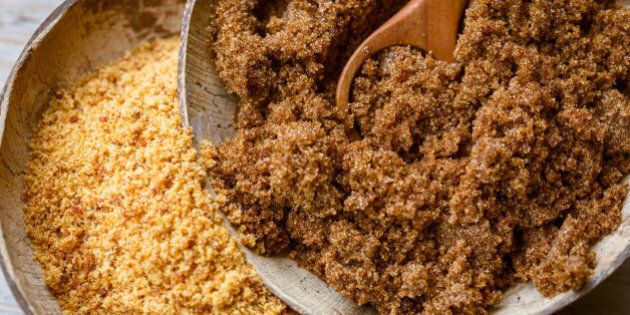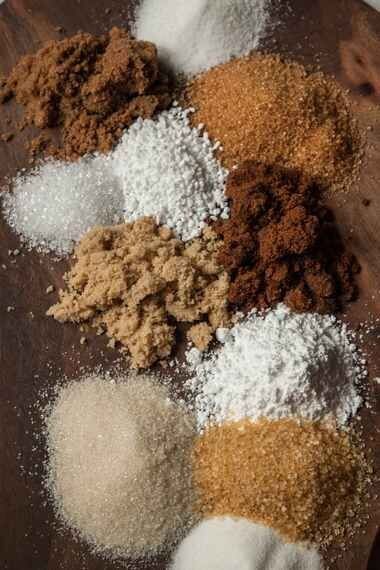

Image courtesy of nairalandnews.com
Did you, like me, overindulge in cheesecakes, gingerbread houses, shortbread cookies, pies, oh so many pies over the holiday season?
Did you, like me, tell yourself that in the new year I'm going to eat cleaner, take in less refined sugar and bake healthier? Yeah, you did.
Too bad, it's not as easy to simply swap white sugar for a natural sweetener in baking. Sugar isn't just about adding sweetness to your baked goods; it carries a different behaviour depending on what you're baking and what the sugar is being combined with.
· It affects texture, adding a chewiness or a crispness to cookies
· It contributes to the fluffiness or moistness of a cake batter
· It changes the colour of the final product
To keep things simple, I'll breakdown two types of sugars that are most commonly called for in baking recipes: liquid and granular.
Recipes that require sugar to be dissolved first are better suited for liquid sugars, which translates to a denser baked good. Recipes that require air bubbles to form rely on granular sugars to cut through the fat, creating a light and fluffy final product.
The simple rule is stick to granular if you're substituting for refined sugar and stick to liquids if you're substituting for sugar water.
Note: Many of us opt for brown sugar thinking it's a healthier option when a recipe calls for white sugar. The truth is commercial refined brown sugar is about 95% white sugar with a thin coat of molasses added to the mix, hence why it's easy to make at home. You know that soft, moist brown sugar found in grocery stores -- that's the refined version.
Here are alternatives to refined white sugar and a little about how they taste.
Remember these are still sugars that give you an energy rush or cause you to crash, it's just a better option than white sugar. The silver lining is that because natural alternatives are sweeter than refined sugar, you end up using less.
Granular

Image courtesy of thekitchn.com
There are four natural sugars worth mentioning that come from the sugarcane family.
Demerara sugar
Taste: Natural, mild, caramel flavour
Texture: Large crunchy grains, sticky
Note: The large crystals don't dissolve well in delicate baked goods however, since it has a nice crunch to it, it's great to sprinkle on top of cakes, cookies muffins, biscuits and pies.
Turbinado (raw sugar)
Taste: Light honey, molasses and caramel flavour
Texture: Finer crystals and less sticky (compared to demerara) as some of the molasses is steamed out of the process
Works with: Anything fruit based or with butterscotch flavours
Muscovado
Taste: Strong molasses flavour because it has a high molasses content
Texture: Darkest of them all, sticky and moist
Works with: Ginger cookies, pound cakes and gingerbread flavours
Jaggery (Indian name gur)
Taste: Earthy, honey flavour
Texture: Comes in powder, liquid or block form
Works with: Recipes that call for nuts and toffee
Note: Jaggery has a ridiculous amount of health benefits. Here's seven.
Liquid

Image courtesy of finedininglovers.com
When baking with liquids, there are some rules to keep in mind, especially when swapping liquids for refined sugar.
1) Reduce the amount of overall liquid in the recipe since liquid adds moisture.
2) Decrease oven temperature by 25 degrees to avoid burning high sugar content.
Agave
Taste: Neutral, clean nectar flavour, less sweet than honey
Texture: Thinner than honey
Works with: Sticky cakes, cookies and muffins
Agave comes from the agave plant, as does tequila, it doesn't crystalize like honey and it's vegan.
Honey
Taste: Depending on the kind, it can taste floral, fruity, with hints of cinnamon, caramel, burnt sugar and more.
Texture: Thick and glossy
Works with: Donuts, icings, anything with cinnamon and fudge flavours
Honey is made up of 20% water. Also, make sure the recipe you're using already calls for baking soda, as baking soda helps balance the acid in honey and helps your baked goods rise properly.
Maple Syrup
Taste: Like honey, there are many grades of maple syrup that give it a unique taste -- smoky, buttery, nutty and of course, the flavour of maple.
Texture: Thick and glazed
Works with: Pecan, bacon, apple and cinnamon flavours, great for tarts, pies and scones.
Maple syrup comes from the sap of maple trees. Similar to honey, maple syrup is acidic, therefore baking soda is needed to help the batter rise.
Cocaine and heroin are less addictive than Oreos. Which makes you wonder why people go to prison for selling the drugs but not for selling the cookies, especially since Oreos and similar foods "may present even more of a danger." - Jacob Sullum, Forbes Contributor
Follow HuffPost Canada Blogs on Facebook